The Sandy Bridge Preview
by Anand Lal Shimpi on August 27, 2010 2:38 PM ESTAdobe Photoshop CS4 Performance
To measure performance under Photoshop CS4 we turn to the Retouch Artists’ Speed Test. The test does basic photo editing; there are a couple of color space conversions, many layer creations, color curve adjustment, image and canvas size adjustment, unsharp mask, and finally a gaussian blur performed on the entire image.
The whole process is timed and thanks to the use of Intel's X25-M SSD as our test bed hard drive, performance is far more predictable than back when we used to test on mechanical disks.
Time is reported in seconds and the lower numbers mean better performance. The test is multithreaded and can hit all four cores in a quad-core machine.
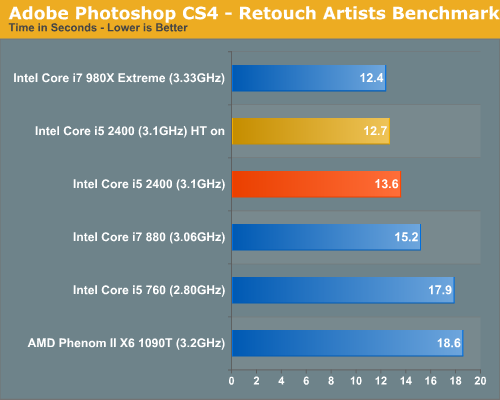
Right off the bat Sandy Bridge is killer. In our Photoshop test it’s faster than its closest quad-core price competitor, faster than its identically clocked Lynnfield, faster than AMD’s fastest and loses out only to Intel’s $999 Core i7 980X. That being said, it only takes about 9% longer to complete our benchmark than the 980X.
DivX 6.5.3 with Xmpeg 5.0.3
Our DivX test is the same DivX / XMpeg 5.03 test we've run for the past few years now, the 1080p source file is encoded using the unconstrained DivX profile, quality/performance is set balanced at 5 and enhanced multithreading is enabled:
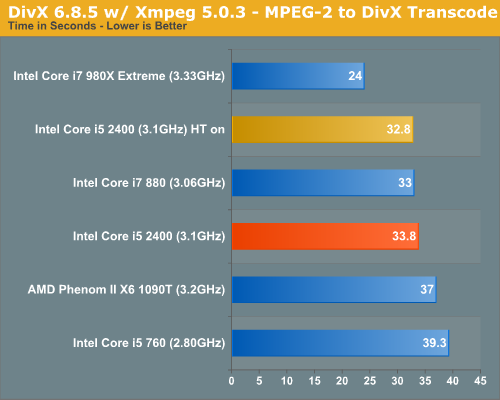
While not the most stressful encoding test, it’s still a valid measure of performance and once again, Sandy Bridge is faster than all. In this case we’re faster than the Core i5 760 (~16%) and just behind the Core i7 880. Clock for clock there's not a huge improvement in performance here (HT doesn't seem to do much), it's just a better value than the 760 assuming prices remain the same.
x264 HD Video Encoding Performance
Graysky's x264 HD test uses the publicly available x264 encoder to transcode a 4Mbps 720p MPEG-2 source. The focus here is on quality rather than speed, thus the benchmark uses a 2-pass encode and reports the average frame rate in each pass.
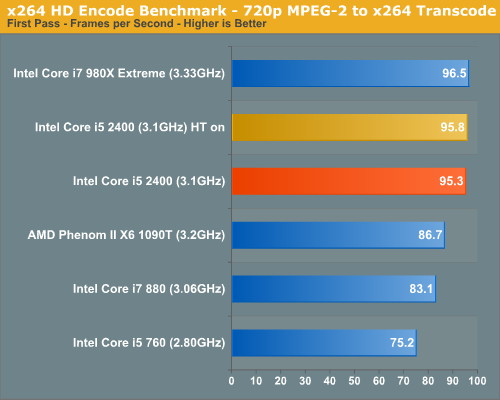
Lightly threaded performance is much improved - the 2400 is 14.6% faster than the Core i7 880.
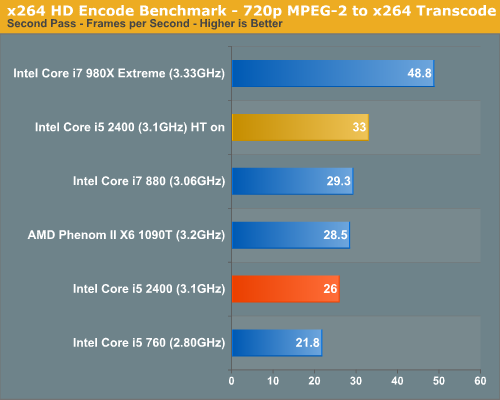
The actual encoding pass favors more threads, so we see a big improvement over the 760 (19%) but it falls short of the Core i7 880. Turn HT on and we get a 12.6% improvement over an identically clocked/configured Lynnfield.
Note that CPU based video encoding performance may not matter if Intel implemented a good video transcode engine in Sandy Bridge.
Windows Media Encoder 9 x64 Advanced Profile
In order to be codec agnostic we've got a Windows Media Encoder benchmark looking at the same sort of thing we've been doing in the DivX and x264 tests, but using WME instead.
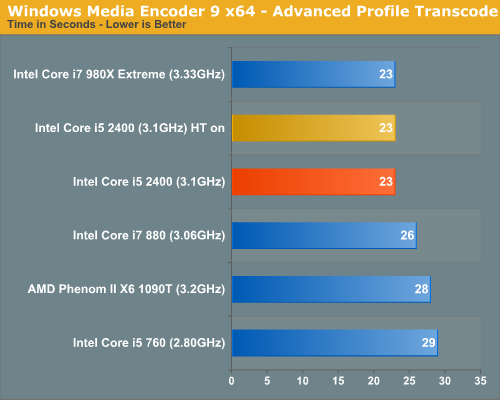
Performance in WME rarely scales anymore. Our benchmark doesn’t scale well beyond 4 cores and the only hope for performance are increases in clock speed or IPC. Sandy Bridge delivers the latter.
A 20% increase in performance vs. the similarly clocked 880 in a test that doesn’t scale with anything but IPC tells you a lot. Compared to the Core i5 760, Sandy Bridge is 26% faster.










200 Comments
View All Comments
Touche - Friday, August 27, 2010 - link
And the naming...OMG!There will be i7 processors that require three (3 !!!) different sockets! Maybe even 4 when 2011 comes. Intel can't get their naming right for quite some time now, but they've outdone themselves this time.
ereavis - Monday, August 30, 2010 - link
Processor names really should mean something, even if AMD and Intel don't agree. It's annoying that I have to wikipedia a processor (or memorize a thousand processors) to know what it is. We are still getting quotes for three year old Opterons and Xeons (that we're using as desktops no less), those only add to the annoyance.What ends up happening - good for Intel bad for technology advancement - is non IT type people buying computers are buying DDR2-667 based three-year old desktop processors.
BSMonitor - Friday, August 27, 2010 - link
Ummm, but Bulldozer comes with AM3-r2... Just a sketchier way of saying new MB needed.At least this new Intel isn't trying to BS you. Significant revisions to the architecture require different pin layouts/counts... It is inevitable with processor evolution.
Touche - Friday, August 27, 2010 - link
Actually, it should be AM3 compatible:http://www.tomshardware.com/reviews/bulldozer-bobc...
Even if it's not, AM2/AM3 lasted quite some time.
"At least this new Intel isn't trying to BS you. Significant revisions to the architecture require different pin layouts/counts... It is inevitable with processor evolution."
They know in advance what they need and could design a socket to support multiple processors. And i7/i5/i3 definitely don't need different ones.
BSMonitor - Friday, August 27, 2010 - link
"Even if it's not, AM2/AM3 lasted quite some time."Not all AM2 processors were compatible with AM2+ MB or vice versa, not all AM3 processors compatible on AM2+ MB.
It's still 3 different sockets.
Marketing buddy, marketing.
By the time 1366 is replaced, it will have been on the market for 4 years.
stmok - Saturday, August 28, 2010 - link
Eh, no its not. Bulldozer does NOT work with non-AM3+ mobosAMD engineers made a decision not to make it backward compatible for three reasons.
(1) No one but enthusiasts upgrade their CPUs. People in the real world upgrade their whole computer.
(2) Bulldozer introduces new features that won't work with existing Socket AM3 mobos. (Isn't it bloody obvious when they have to introduce a new socket specification?)
(3) It would cost more money and delays if they were to make a backward compatible version of Bulldozer.
As a result, they made a compromise:
You can take your existing AM3 CPU to AM3+ mobos, while you wait for Bulldozer to arrive. BUT, you can NOT upgrade your existing AM3 based system to Bulldozer.
Simply put...
AM3+ CPU and AM3+ mobo = OK
AM3 CPU and AM3+ mobo = OK
AM3+ CPU and AM3 mobo = Sorry. No.
So it doesn't matter if AMD "Bulldozer" or Intel "Sandy Bridge". You will need a new mobo.
Ard - Friday, August 27, 2010 - link
AMD seriously has their work cut out for them with Bulldozer. The lowest end Sandy Bridge processor absolutely trounced the competition. It's insane what Intel is pulling off here, especially in the integrated graphics arena. Really makes me hope Larrabee comes back as a discrete product in the next few years.dgz - Saturday, August 28, 2010 - link
poor kid, you don't realize 2400 is not nearly lowest end.Finally - Sunday, August 29, 2010 - link
Doesn't that make him a "(filthy) rich kid"?Quodlibet - Friday, August 27, 2010 - link
- based on the shown roadmap, the replacement for the i5 760 is actually the i5 2500(K).- i7 will have even better performance with 8 MB L3 Cache and higher graphics turbo. So there is even more performance potential in the SandyBridge die that Intel could unlock for lower SKUs if needed.